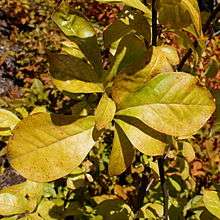Orixa japonica
Orixa japonica, commonly called East Asian orixa[2] or Japanese orixa, is a deciduous shrub growing to 3 metres (10 ft) with an equal spread.[3] Native to Japan and South Korea, it is found on forested, sunny slopes at elevations from 500 to 1300 m.[4] A recent scientific study found this plant to contain previously unknown alkaloids that may be effective against Plasmodium falciparum, one of the protozoan species that cause human malaria.[1]
| Orixa japonica | |
|---|---|
 | |
| Japanese orixa[1] (Autumn foliage) | |
| Scientific classification | |
| Kingdom: | |
| (unranked): | |
| (unranked): | |
| (unranked): | |
| Order: | |
| Family: | |
| Subfamily: | |
| Genus: | Orixa |
| Species: | O. japonica |
| Binomial name | |
| Orixa japonica Thub. | |
This plant has an unusual and distinctive leaf pattern. Starting from the oldest leaf, the pattern of angles of subsequent leaves is 180 degrees, 90 degrees, 180 degrees, and 270 degrees. The pattern then repeats.
 Flowers
Flowers Fruit
Fruit
References
- Cirrus Digital: Japanese Orixa Orixa japonica Retrieved 22 Feb. 2013
- English Names for Korean Native Plants (PDF). Pocheon: Korea National Arboretum. 2015. p. 553. ISBN 978-89-97450-98-5. Archived from the original (PDF) on 25 May 2017. Retrieved 4 January 2017 – via Korea Forest Service.
- "Orixa japonica (Japanese Orixa)" Canada Plants. Retrieved 8 September 2013.
- eFloras.org Chinese Plant Names, Orixa japonica Thunb.
External links
- Photo Database from University of South Florida

This article is issued from Wikipedia. The text is licensed under Creative Commons - Attribution - Sharealike. Additional terms may apply for the media files.